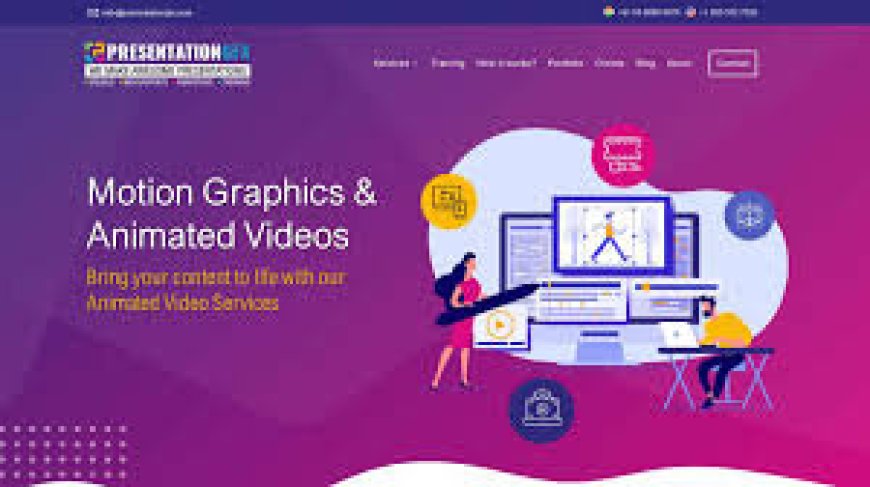What is Animating Motion Graphics and How Can It Enhance Your Visual Content?
One of the most engaging forms of visual content is animating motion graphics. This dynamic and versatile medium can transform static designs into lively, attention-grabbing visuals.

What Are Motion Graphics?
Motion graphics are animated graphics that combine text, shapes, and other visual elements to create a dynamic and engaging visual experience. Unlike traditional animation, which often focuses on characters and storytelling, motion graphics typically emphasize abstract visuals, typographic elements, and data visualization. This medium is widely used in various fields, including advertising, film, television, and digital media, to convey information and captivate audiences.
Why Animate Motion Graphics?
Animating motion graphics offers several advantages that make it a valuable tool for visual content creation:
-
Increased Engagement: Motion graphics can capture and hold viewers' attention more effectively than static images or text. The movement and dynamic elements draw people in and keep them engaged with the content.
-
Enhanced Communication: Complex ideas or data can be communicated more clearly through motion graphics. By animating graphs, charts, and infographics, you can simplify and illustrate information in a way that's easy to understand.
-
Brand Identity: Consistent use of animated motion graphics can help reinforce brand identity. Custom animations that align with your brand's style and message contribute to a cohesive visual identity.
-
Versatility: Motion graphics are highly versatile and can be adapted to various formats, including social media posts, advertisements, explainer videos, and more. This flexibility allows for creative freedom and experimentation.
Key Techniques in Animating Motion Graphics
To create effective motion graphics, you'll need to familiarize yourself with several key techniques. Here are some fundamental techniques and concepts used in animating motion graphics:
1. Storyboarding
Before diving into animation, it's essential to plan your visuals. Storyboarding involves sketching out the sequence of animations and transitions. This helps you visualize the flow of the content and ensures that all elements are aligned with the overall message.
2. Timing and Spacing
Timing and spacing are crucial elements in animation. Timing refers to the duration each frame or element is displayed, while spacing determines the distance between keyframes. Proper timing and spacing create a smooth and natural movement, making the animation more appealing and realistic.
3. Keyframes
Keyframes are the foundation of animation. They mark the start and end points of a transition or movement. By setting keyframes at specific intervals, you can create the illusion of motion and change over time.
4. Easing
Easing refers to the gradual acceleration or deceleration of motion. This technique helps create more natural and fluid animations. Common easing types include ease-in, ease-out, and ease-in-out, each affecting how the animation starts, progresses, and ends.
5. Motion Paths
Motion paths are the trajectories that animated elements follow. By defining a motion path, you can control the direction and movement of objects within your animation. Motion paths are particularly useful for creating complex movements and transitions.
6. Layering
Layering involves stacking multiple visual elements on top of each other to create depth and complexity. By animating different layers independently, you can add dimension and richness to your motion graphics.
7. Typography Animation
Typography animation involves animating text elements to enhance their visual impact. Techniques such as text reveal, text bounce, and text morphing can make textual content more engaging and memorable.
Tools and Software for Animating Motion Graphics
To bring your motion graphics to life, you'll need the right tools and software. Here are some popular options used by professionals in the industry:
1. Adobe After Effects
Adobe After Effects is one of the most widely used software for animating motion graphics. It offers a comprehensive set of tools and features for creating complex animations, visual effects, and compositing.
2. Adobe Animate
Adobe Animate is another powerful tool for creating vector-based animations. It provides a range of features for designing interactive animations and is ideal for web and mobile applications.
3. Cinema 4D
Cinema 4D is a 3D modeling and animation software that integrates well with motion graphics. It allows for the creation of intricate 3D animations and visual effects, adding a new dimension to your projects.
4. Blender
Blender is a free and open-source 3D creation suite that includes features for animation, modeling, and rendering. It's a versatile tool for animating both 2D and 3D motion graphics.
Tips for Creating Effective Motion Graphics
To maximize the impact of your motion graphics, consider the following tips:
1. Keep It Simple
Simplicity is key to effective motion graphics. Avoid cluttering your animations with too many elements or effects. Focus on conveying your message clearly and concisely.
2. Align with Branding
Ensure that your motion graphics align with your brand's identity and message. Use colors, fonts, and styles that reflect your brand's personality and values.
3. Use Visual Hierarchy
Create a visual hierarchy by emphasizing important elements and guiding the viewer's attention. Use size, color, and animation to highlight key information and direct focus.
4. Incorporate Sound Design
Sound design can enhance the impact of your motion graphics. Consider adding background music, sound effects, or voiceovers to complement the visual elements and create a cohesive experience.
5. Test and Iterate
Before finalizing your motion graphics, test them with a sample audience to gather feedback. Use this input to refine and improve your animations, ensuring they effectively communicate your message.
Applications of Motion Graphics
Motion graphics are used in various applications, each serving a different purpose. Here are some common use cases:
1. Advertising and Marketing
In advertising and marketing, motion graphics are used to create eye-catching commercials, promotional videos, and social media content. They help grab attention and communicate key messages effectively.
2. Explainer Videos
Explainer videos use motion graphics to break down complex concepts and processes. They are commonly used for product demonstrations, educational content, and company overviews.
3. Title Sequences and Intros
Motion graphics are often used in title sequences and intros for films, TV shows, and online videos. They set the tone and style for the content that follows.
4. Data Visualization
Motion graphics are effective for visualizing data and statistics. Animated charts, graphs, and infographics can make data more accessible and engaging.
5. Educational Content
In educational settings, motion graphics can enhance learning materials by illustrating concepts, processes, and historical events. They make complex information more engaging and easier to understand.
Future Trends in Motion Graphics
As technology continues to evolve, motion graphics are likely to see new advancements and trends. Here are some emerging trends to watch for:
1. Integration with Augmented Reality (AR) and Virtual Reality (VR)
Motion graphics are increasingly being integrated with AR and VR technologies. This combination allows for immersive and interactive experiences, enhancing engagement and storytelling.
2. AI-Driven Animation
Artificial intelligence (AI) is starting to play a role in animation, automating certain aspects of the animation process and enabling more sophisticated visual effects.
3. Real-Time Animation
Real-time animation tools are becoming more popular, allowing for live and interactive animations that respond to user input and real-time data.
4. Personalization
Personalized motion graphics tailored to individual preferences and behaviors are gaining traction. This trend allows for more targeted and relevant visual content.
Conclusion
Animating motion graphics is a powerful way to create engaging and impactful visual content. By understanding the techniques, tools, and applications of motion graphics, you can enhance your content strategy and effectively communicate your message. Whether you're working on marketing materials, educational content, or data visualization, incorporating motion graphics can elevate your visuals and captivate your audience. Stay ahead of the curve by embracing emerging trends and continuously refining your skills in animating motion graphics.
What's Your Reaction?
























